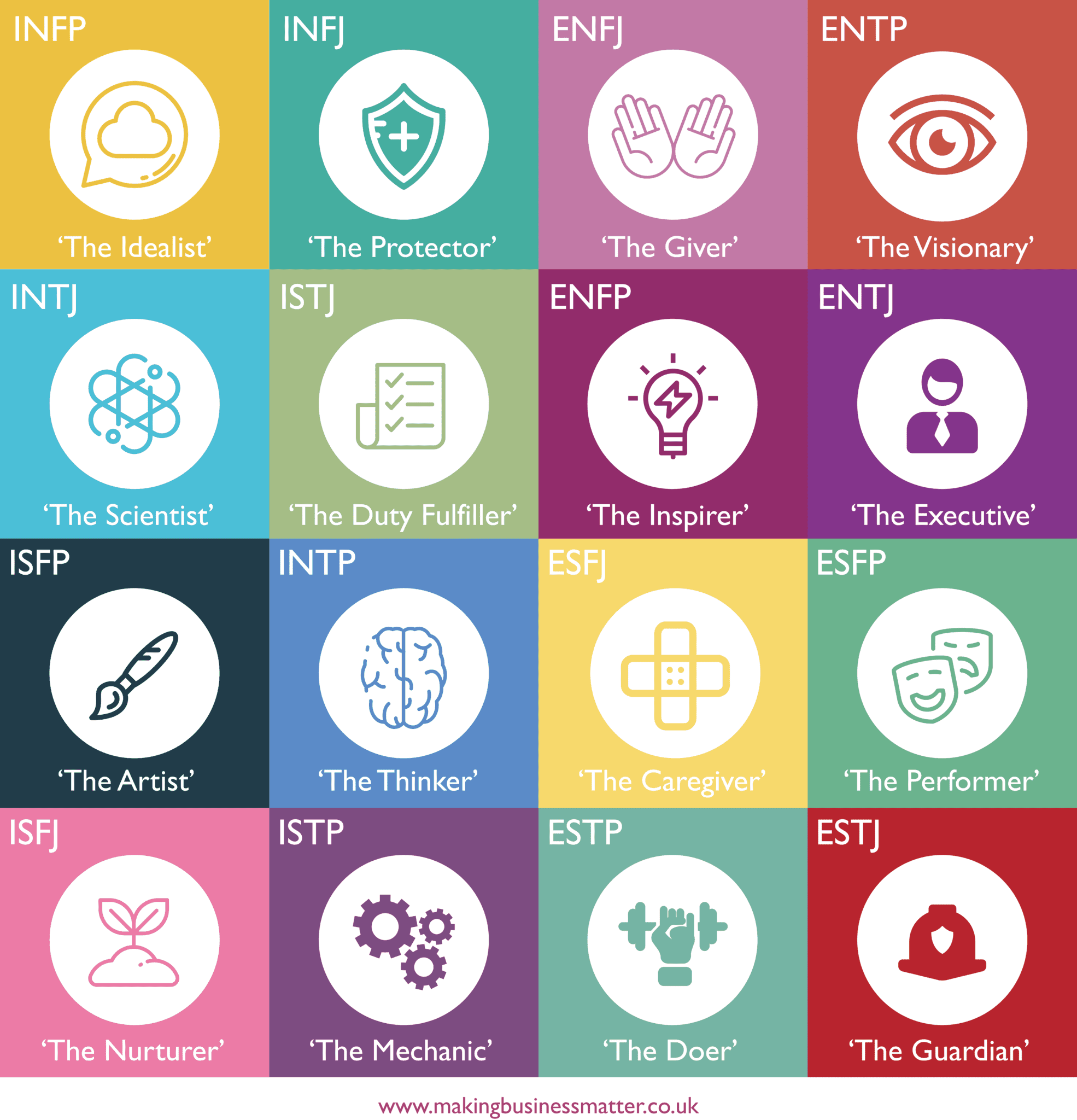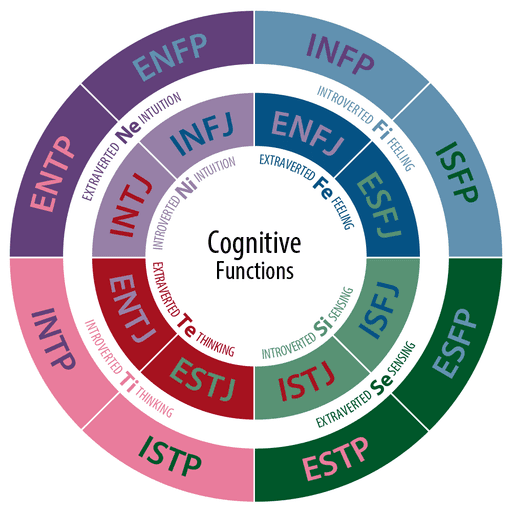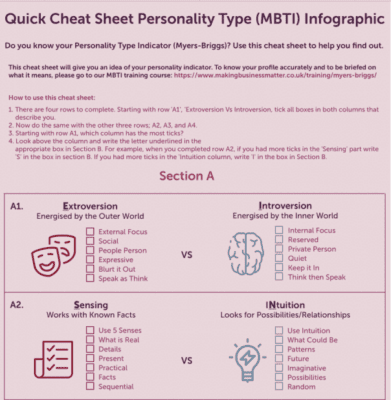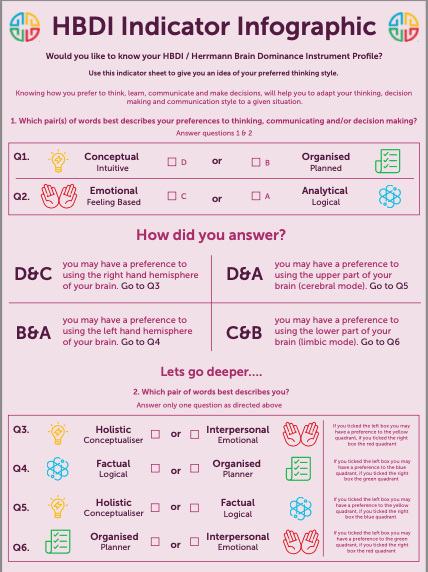Preference Assessments/Personality Tests
Whether your organisation achieves success or not, it all depends on those you task with making it happen. In particular, their motivation, way of thinking and approach to tasks are critical. But even more important, is how you align their different personal preferences in thinking and problem solving so that they form a team that is cohesive enough to focus on common goals effectively.
Indeed, perfect teams can happen by chance, but as a serious business, leaving things to chance is, of course, not a reliable strategy. To assure yourself of good results, you need to be on top of things, and that includes consciously designing your teams to be perfect at reaching set goals.
That calls for doing preference assessments before, during and after forming your teams. In fact, preference assessment— sometimes referred to as personality tests — is a critical component of human resource management. Preference assessments empower each team member to truly understand themselves first and then those they work with. And that almost always leads to better results.
Every major brand you know—Coca Cola, Microsoft, Apple…you name it—takes the concept of personality types and personality preferences very seriously in their people management. According to a 2014 survey, over 60% of HR departments are using some form of personality test or assessment. And that compares to 29% in 2001.
With a deep understanding of how different people process information and arrive at solutions, you find it easy to make your systems and processes efficient. In particular, you would know how to form teams that you expect to take on specific tasks. People get along well and are more productive if they accept and understand their different personalities.
Preference Assessment/Personality Test?

A personality test is a structured scientific examination of an individual to understand their distinctive character. That includes their view of the world, what drives them, and what motivates them. A side note: The word ‘test’ is, however, a misnomer. That is because there are no right or wrong answers during this examination. In fact, the more appropriate description for it is preference assessment.
It turns out that even though everyone is unique, people can be grouped into personality type categories using scientifically measurable traits. Scientists have studied personality traits for centuries. And one result of this long term study is the designing and development of various assessment instruments.
Over the years, different preference assessment instruments have been developed to help individuals, teams and organisations to develop themselves so that they almost always find a path of least resistance in regard to how they approach and solve problems.
Preference Assessments Fall into the Following Four Categories:
1. Thinking-Based or Brain-Based Assessments
This is an assessment tool that focusses on determining how individuals and even teams process information and formulate solutions to problems at hand. You cannot really describe a tool in this category as a personality test, even though many do so often. An example of an assessment tool in this category that is widely used is the Herrmann Brain Dominance Instrument (HBDI), more about it below.
Sticky Learning ® is 7 times more effective than 1-day training courses. Plus, you will get a Chain of Evidence proving your Return on Investment. Discover soft skills training that changes behaviours long term.

2. Talent, Interest or Career Assessments
This is a preference assessment that focuses on abilities, talents and other aptitudes someone might have. An assessment in this category could be useful when hiring and, in particular, if you need people with specific qualities. You cannot, however, rely on it to help you design a process your team needs to use to solve problems.
3. Psychologically Based Assessments

This one focuses on what motivates people to do what they do and how they react to given situations. It also looks at a person’s emotional status. Indeed, we can describe assessments in this category as personality tests as they attempt to define what makes a particular individual. An example of an assessment in this category that is most used around the world is the Myers Briggs Type Indicator (MBTI). Learn more about MBTI below.
4. Behaviour-Based Assessments
This is a preference assessment that focuses on how people react to how others in their proximity perceive them. It also seeks to identify how individuals express themselves in the presence of and to others. An example of a preference assessment in this category is DiSC, more about it below.
What Else Do Personality Tests Achieve?
Besides human resource management, understanding personalities can help your business in one other critical way. It allows you to understand your customers better. And with that, you can target them with communications that resonate with them. And this is important in particular because you intend to persuade them. If your target audience is, for example, more analytical than intuitive, you may need to package your message with detailed data and graphs more than just persuading narratives.
However, a casual sit down with someone is not enough to help you figure out who they are, what drives them, and how they perceive the world. And even more importantly, how their personality type can fit well into helping your business achieve its goals. And that is where personality tests and preference assessments come in.
It is important to point out that not everyone agrees that personality tests are useful. Some people think they are more or less similar to Horoscopes or Tarot card reading. The particular criticism is that they are popular because of the Barnum effect. That means someone feels the test results describe them simply because a little bit of every personality trait is in every person.
But still, the use of personality tests and preference assessments in human resource management is on the rise. It is not possible that all the organisations, including Fortune 500 companies, using these assessments are all mistaken and are spending close to $1 billion annually on something that is not giving them returns.

Source of Data for a Personality Tests
Of course, the backbone of personality tests and preference assessments is data. And the credibility of the results you get depends on how you collect the data. The following are the common ways you can get data for a personality test:
1. Self-Reporting
The subjects provide the data often as answers to questions. For easy analysis, the answers come in the form of multiple choices. Giving questions is the easiest way to perform a personality test. It takes a relatively short time and does not require a lot of preparation and resources. But it has its disadvantages. The major shortcoming of this method of collecting data for personality tests is that often people want to present the best of themselves.
If someone is doing a job interview, for example, they might answer the questions in a way they think will impress the potential employer. In the end, the assessment might not give the actual character traits or thinking process of the person taking it.
And it is for this reason that self-reported data, especially regarding personality analysis, does not meet scientific or clinical research standards. However, depending on how well we design the assessment, we can glean objective self-reported data.
The Herrmann Brain Dominance Instrument, for example, (HBDI), uses self-reported data. However, they have built a system that manages well how the subject answers the questions so that the data is still credible even though it is self-reported. It is a hard-to-fool psychological self-reported data exam.
2. Observers Reporting
This is where you have an objective observer or third party to collect the data. The observer must have the skill to capture the nuanced, relevant data. The data you collect this way is less biased as compared to what you get from a self-reported process. The observation can be naturalistic or artificial.
Naturalistic observer-reported data is collected while the subject is in their natural surroundings and going on with their daily routine. Often they are not aware that they are under observation. This can provide the best data for personality traits or thinking style determination.
And that is because people are their true selves when they are in their own environment and in particular if they are not aware someone is watching them. However, it is tricky to observe people without their knowledge. It is unethical and, in many cases, outright illegal.
Meanwhile, artificial observer-reported data is what we collect with the subject in a test environment and also aware that someone is studying them. Indeed, they have to grant permission for the test to be administered. There is one shortcoming of this way of collecting data. With the subject in a new environment and being aware that a researcher is watching them, they might change their routine.
3. Supervised Test

This way of collecting data for personality assessment is relatively more formal compared to others, and it is carried out in a confined setting. It is indeed a form of artificial observation. An expert asks questions and then observes as the person being assessed answers them.
To understand their personality type or preference, the answers they provide and their physiological reactions during the exercise are noted and interpreted using a given instrument. In some instances, the questions are posed on a screen or a piece of paper. Whatever the case, the answers provided and the reaction to the question matter in the final assessment of the personality type or thinking style.
4. Longitudinal Research
This is the study and determination of one’s personality that takes a long time—weeks, months or even years. It is particularly useful when determining how their physical environment, social setting, and genetics affect who they become. It turns out where we are born and brought up, the genes we inherit and the people around us in the long term influence a lot who we become and how we approach issues.
These factors also impact how we interact with the world around us. But a quick sit down test might not reveal a lot about this. A long term study is more useful. Often longitudinal research is necessary, in particular, when our cultural background becomes an essential factor to consider.
5. Projective Test Data
It is human nature only to let the world see what we think it should know about us. We walk around wearing masks. It is what renowned psychologist Carl Jung described as a persona. It often misrepresents who we are inside.
Many times we don’t want people to see who are. And that is because we are embarrassed, we think it will work against us or alienate us. Sometimes we are too preoccupied with our persona to realize there is more to who we are.
A Projective test is designed to uncover the individual behind the public persona. It seeks to peel the mask and reveal the hidden thoughts and unconscious behaviours.
The subject usually sees ambiguous images, and they say what comes to their mind.
The answer can reveal an individual’s thought process and, by extension, their inner character.
A form of projective test known as thematic apperception test (TAT) uses images in a sequence. The subject is asked to tell the unfolding story as they see it.
Three Most Used Preference Assessment Instruments

A preference assessment instrument is a collection of questions and a mode of interpreting the individual who provides the answers. There are many personality tests systems out there. In this post, we are going to explore the following:
- Myers Briggs
- DISC assessment
- HBDI
These three are the most used. These personality tests and preference assessments differ in several ways. The differences include the ease of administering them and the kind of personality traits or mind process they reveal. The more meaningful preference assessments for businesses are those that identify how an individual interacts with others, what motivates them, how they process information, and how they perform under given conditions.
1. DiSC Assessment
You probably know someone who comes alive when they are stationed at locations where they interact with different kinds of people, such as at the front desk. They always wear a smile, keenly listen to what others are saying with radiant eyes and seem not to struggle to find what to say, even to strangers. It is because they are most likely people-oriented, according to DiSC. You also most likely know someone who seems to be always in a hurry when they meet you.
It is like they do not want to spend more than the necessary time with you. They are also likely to lock themselves in their office or choose a quiet corner far away from everyone else to work on a project, such as the new application everyone at the office is waiting for. According to DiSC, such people are task-oriented.
DiSC is a behaviour-based personality assessment, which is one of the best-known creations of American psychologist William Moulton Marston. He lived between 1893 and 1947. Other creations of Professor Marston are the early version of the lie detector and the comic book superheroine Wonder Woman.
DiSC is a self-reported data preference assessment that uses two pairs of primary traits to determine someone’s personality type. According to DISC, someone is either Outgoing or Reserved and either Task-oriented or People-oriented.

The following are the four personality types that come out the two pairs of primary traits:
Dominant or Drivers (D)
People in this category are both Outgoing and Task-Oriented. They are dominant and like being in control. They are always ready to take leadership roles.
Influence (I)
The people in this category are both Outgoing and People-Oriented. They enjoy being in high energy crowds, and they are not shy to stand out.
Steadiness (S)
People in this category are both Reserved and People-Oriented. They like being around people but not the high energy kind of crowds and usually avoid conflicts. They are also hesitant to take a leading role, but they are always ready and willing to support others.
Conscientiousness or Compliant (C)
People in this category are both Reserved and Task-Oriented. They are more logical, organized, and make decisions after considering everything that can go wrong. They are hesitant to delegate and prefer doing everything by themselves.
What Makes DISC a Great Tool?
The DISC personality test is quite easy to understand, administer and interpret. This tool is handy in identifying particular behaviours, and that can be very helpful in human resource management. It has also been identified as great for marketing. It very valuable for market segmentation and targeting.
What Makes Disc Not a Priority Tool?
Some versions of the test treat the two pairs of traits as absolute binaries that you are either wholly outgoing or wholly reserved. Or completely task-oriented or people-oriented. In real life, being outgoing is an extended-spectrum. Most people fall anywhere along that spectrum. The same is true for being people or task-oriented. People are a lot more nuanced than this test can prove. You also have to choose from several versions of the test.
2. Myers-Briggs Type Indicator
Click the image below for a higher resolution.

You probably want to know why one of your friends is almost always too quiet when you are in a group. Or why another seems to be spontaneous and always seems to make rushed decisions but still surprises everyone by almost always getting things right. These are different personality types according to MBTI. Your quiet friend most likely has an introversion trait.
Meanwhile, your spontaneous friend is intuitive. MBTI provides the mechanism for not only categorizing, but also understanding people’s personal traits in great detail.
The origin of the Myers-Briggs Type Indicators (MBTI) personality test is a book that renowned Swiss psychologist Carl Jung published in 1921. In the book titled Psychological Types, Jung explains that humans are either perceivers or judgers.
He then states that perceivers can further fall into those who rely on Sensing and those who are dependent on Intuition. Meanwhile, he split judgers into Thinkers and Feelers. All these four types are either introvert and extrovert. And this results in eight personality traits.
But it was Katharine Cook Briggs (1875–1968) and her daughter, Isabel Briggs Myers, who turned Carl Jung’s ideas into a psychological-based personality type system in the 1940s. It is important to point out that Katharine and Isabel had no formal training in psychology. As Psychology Today pointed out in their excellent article in defence of Myers Briggs, this has been the foundation many have used to discredit the test.
MBTI is an assessment that seeks to explain the baseline psychological make up of an individual. In particular, how they may react to certain situations. Understanding the psychological baseline of ourselves and others could help us figure out how to avoid personal conflicts or make co-operation at the workplace more productive.
With that said, the two took and renamed the following Carl Jung’s eight traits:
- Extraversion(E)-a trait of enjoying being around people more than being alone.
- Introversion (I)-it is a trait that is the opposite of Extraversion.
- Sensing (S)-a trait of accepting and believing information received from outside self
- Intuition (N)-This is the opposite of Sensing, and it is a trait of relying on inner or instinctive information.
- Thinking (T)-it is a trait of understanding the world around through logic and reason.
- Feeling (F)-it is the opposite of Thinking, and it is a trait of understanding the world around through emotion.
- Judging (J)- a trait of preferring order and organization
- Perceiving (P)- it is a trait opposite of Judging, and it is a trait of being spontaneous.
Click the image below for a higher resolution.

16 Personality Types
By picking a trait from each pair, Katharine and Isabel were able to generate 16 possible personality types, as listed below.
For an overview of all 16 personality types, check out our MBTI articles page which features an in-depth look at each personality type.
What Makes Myers-Briggs Type Indicator Great?
It provides a lot more personality types (16) than the rest of the personality test systems. You can use it to identify the personalities you want to have around you. It also has one of the highest numbers of people who have taken it—over 2 million.
However, its most significant shortcoming is that they treat personality traits as binaries. Most people fall on a spectrum. The majority of people lie somewhere between Introversion and Extroversion. It is also not designed to meet a wide range of business needs as compared to HBDI, for example. In particular, it does not help with determining how individuals process information and approach problems, something important in a business environment.
In 2015 Vox published an article explaining why MBTI is meaningless. They quoted an organisational psychologist who asserts that it is ineffective in particular because it can give different results to the same individual. In the face of mounting criticism over the effectiveness of the MBTI, the President, and CEO of CPP, the company that owns the global rights to the test, Jeff Hayes, has given caution on the use of the instrument;
It [MBTI] is not, and was never intended to be predictive, and should never be used for hiring, screening or to dictate life decisions.”
Click on the below image for an enlarged PDF of our MBTI cheat sheet, for a quick and easy way to understand your personality type.

3. Herrmann Brain Dominance Instrument (HBDI)
You’ve probably observed in your office meetings that there is that one member of the team who is always asking number related questions and often takes out the calculator to confirm values before being persuaded. You probably think they are overly analytical. Or another, who always insists on having a very detailed plan before anything is done. You may describe them as overly organized. Then you know someone who is always concerned about how what you decide to do will make others feel. They are at least a bit emotional. All these are different preferences for problem-solving according to HBDI.
HBDI is almost the only preference assessment instrument designed with a primary business goal. It used as a tool for enhancing how individuals and teams process information and solve problems in a business environment. Also, unlike the other personality test instruments, HBDI can be scaled. We can use it to determine how an individual processes data and solves problems. Still, we can also use it to measure and map the combined capability of a team and even an entire organization.
So if your intended use of a personality test is to figure out how you can streamline your organisation’s process, then this should be the instrument you should consider using. As David Nour notes in his excellent Forbes article, HBDI is very highly rated as it allows you to appreciate and embrace those who think differently to you.
Ned Herrmann
HBDI was designed and developed by William Edward Ned Herrmann in the late 1970s. At that time, he served as the resource development manager at General Electric (GE). His primary goal while developing the test was to identify the learning preferences of members of the GE staff. And from this design training programs that increase productivity, creativity, and motivation. His approach showed a lot of success at GE and elsewhere. In 1992, the American Society for Training & Development (ASTD) gave him the Distinguished Contribution to Human Resource Development Award.
While the other personality tests are focused on your traits or your psychological baseline, HBDI is more about how an individual, a team, or an organisation chooses to process information and find solutions. This makes it very useful in situations where appropriate decisions are very important or translate to impactive results.

According to the HBDI model, the human brain thinks in the following four ways:
- Analytically
- Practically
- Relationally
- Experimentally
Each of these ways of thinking and processing data happens in specific areas of the brain. Studies, from as far back as the 1940s, have shown that the human brain functions in quadrants. HBDI identifies four sides of the brain, with each being responsible for a specific mode of problem-solving.
The first quadrant is the top left side of the brain.
When it is the dominant quadrant in someone, they tend to use logic and reason to process information and find solutions. We represent this quadrant with the colour blue in the HBDI charts.
The second quadrant is the bottom left part of the brain.
When this part of the brain is dominant, one tends to be organised, detailed. One prefers structure and form. The colour green represents this quadrant in HBDI charts.
The third quadrant is the bottom right side of the brain.
When this part of the brain is dominant, one tends to be emotional and likes forming relationships with other people. The colour red represents this quadrant on the HBDI charts.
The fourth quadrant is the top right side of the brain.
When this quadrant is dominant, one tends to be a risk-taker. They also tend to be intuitive and look at things in the big picture. We represent this quadrant with the colour yellow in HBDI charts.
Everyone uses all these quadrants, and it just happens that one is often dominant than the rest. The purpose of doing an HBDI test is to figure out which one is dominant. And as a result, take the necessary training to make the one you need for your kind of work dominant. The test comes in the form of 120-questions you will answer in about 30 minutes.
What Makes HBDI a Great Tool?
It is the only personality test tool whose primary goal is to help businesses improve their productivity. In particular, we can apply the test to an individual but also teams and even the entire organisations. It is also a very nuanced test. It takes into consideration how an individual reacts when under pressure and when not under pressure.
Over 2 million people in over 45 countries have taken the HBDI examination. Hundreds of scholarly articles about the test exist, and close to 30 books have it as a subject. It is also available in over 26 languages. Meanwhile, global brands, including IBM, Coca-Cola, Kraft, Goldman Sachs, and Target, use it for human resource management. Also, the Association for Talent Development (ATD) have accredited the HBDI test.
Click on the below image for an enlarged PDF of our HBDI Indicator infographic.

This infographic quickly helps you understand which part of the brain is your preference.
Other Personality Tests
- The Big Five
- Rorschach
- Hexaco personality inventory
- Winslow Personality profile
Summary
We started this blog post by looking at what personality tests and preference assessments are, how data for determining personality types is collected, and what personality tests and preference assessments achieve. We then looked in detail at the three most used preference assessment instruments; DISC, Myers-Briggs Type Indicator (MBTI), and Herrmann Brain Dominance Instrument (HBDI). In particular, we explored how each works as well as their strengths and weaknesses.
Want to Learn More?
If you want to learn more about any of the personality tests mentioned in this post, feel free to get in touch. We have several personality test Certified Practitioners, who are in the best position to provide the most appropriate guidance possible on how to make these tools very useful to your business or career.




